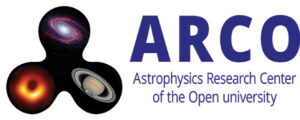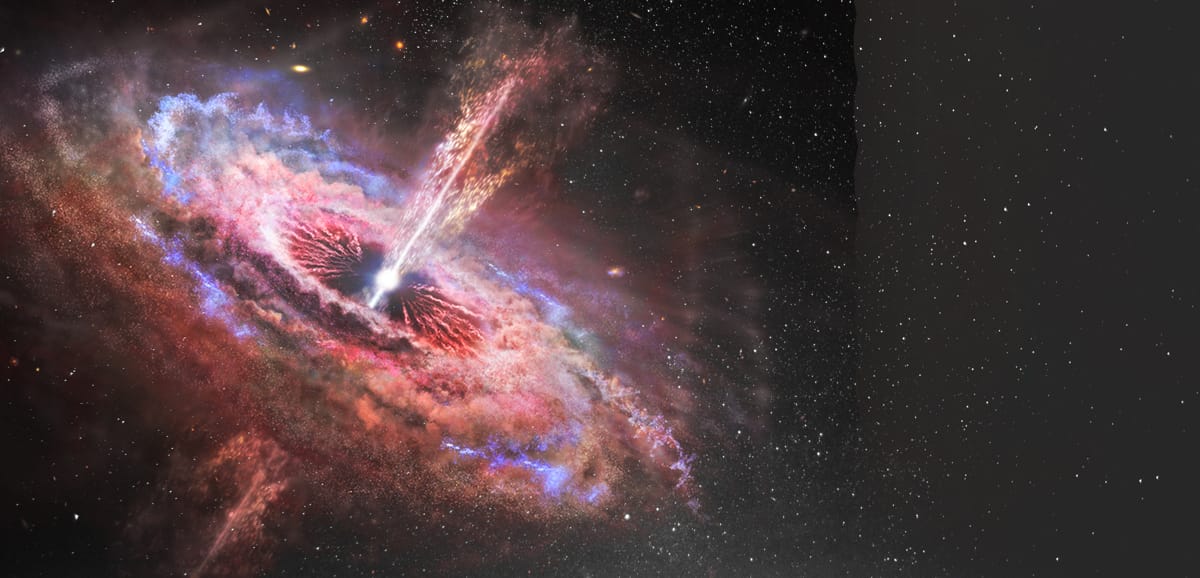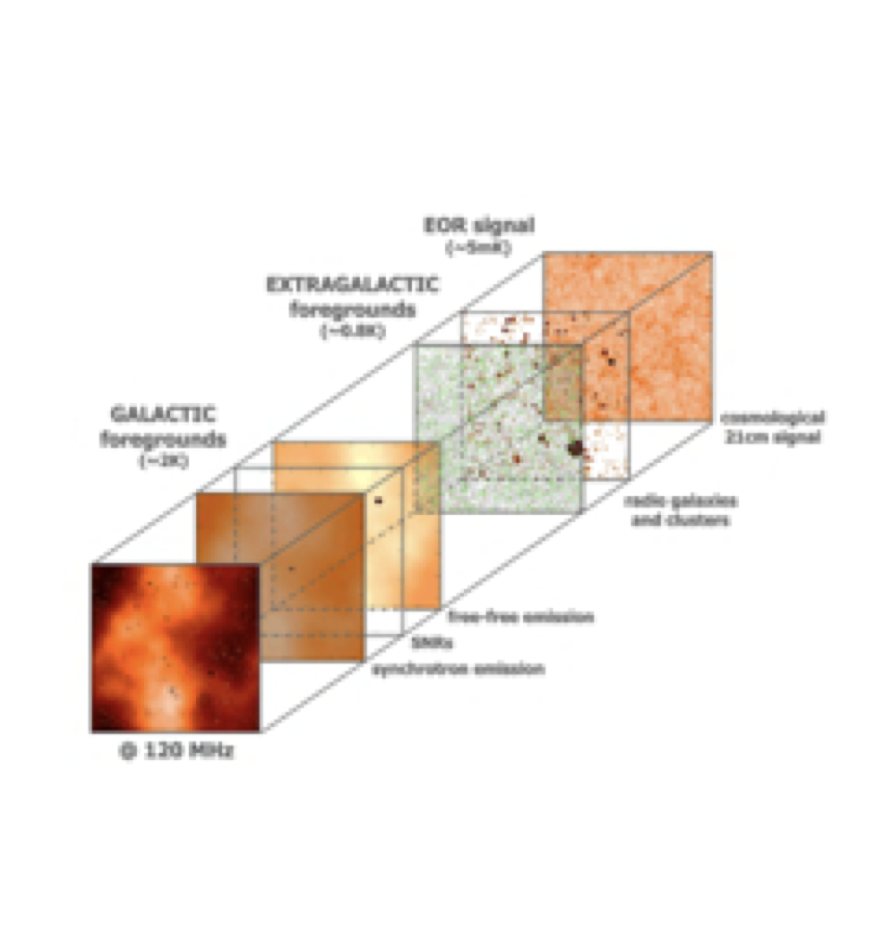
The Foregrounds of the 21 cm Experiments:
Paper: Jelic, V., and 12 colleagues 2008. Foreground simulations for the LOFAR-epoch of reionization experiment. Monthly Notices of the Royal Astronomical Society 389, 1319-1335.
The redshifted 21 cm, especially, its EoR era, has been the target of a number of ground-based radio observato- ries, especially, radio interferometers. There are a number of recently built and planned new-generation radio telescopes that have produced already a large amount of data, such as GMRT, LOFAR, MWA, 21CMA and PAPER; the newly built HERA and NenuFAR and the planned SKA. Most of these telescopes aim, among other things, to capture the lower redshift part of the evolution of the 21 cm radiation (z<12). Unfortunately, however, none of them, with the exception of the very new telescope HERA and the planned SKA, have enough signal-to-noise to provide images of the EoR as it evolves with redshift. Instead, they are all designed to detect the signal statistically.
The main reason is that the signal is very feeble relative to the galactic and extragalactic foregrounds and goes through significant contamination as it goes through the earth’s ionosphere and instrument response effects. The synchrotron and free-free radiation from the Milky Way and other extragalactic sources dominates the sky by many orders of magnitude in bright- ness (see Figure 2). Nevertheless, since the foreground emission varies smoothly with frequency, one can differentiate it from the rapidly fluctuating 21 cm signal. This is, however, not as simple as it sounds, since ionospheric and the frequency-dependent response effects of the radio telescopes complicate the fre- quency structure of the, otherwise spectrally smooth,
 Figure 2: A figure showing the various extra-galactic and galactic components that contribute to the 21 cm measured signal at a given frequency. These foregrounds have amplitudes of about 3 orders of magnitude larger than the expected cosmological signal as indicated from the root-mean-square of each component shown in the figure. (Jelic et al, 2010)
Figure 2: A figure showing the various extra-galactic and galactic components that contribute to the 21 cm measured signal at a given frequency. These foregrounds have amplitudes of about 3 orders of magnitude larger than the expected cosmological signal as indicated from the root-mean-square of each component shown in the figure. (Jelic et al, 2010)

Upper limits from The LOFAR EoR KSP
Paper: F.G. Mertens, M. Mevius, L.V.E. Koopmans, A.R. Offringa, G. Mellema, S. Zaroubi, M.A. Brentjens, H. Gan, B.K. Gehlot, V. N. Pandey, A. M. Sardarabadi, H. K. Vedantham, S. Yatawatta, K. M. B. Asad, B. Ciardi, E. Chapman, S. Gazagnes, R. Ghara, A. Ghosh, S. K. Giri, I. T. Iliev, V. Jelic ́, R. Kooistra, R. Mondal, J. Schaye, and M. B. Silva. Improved upper limits on the 21 cm signal power spectrum of neutral hydrogen at z ≈ 9.1 from LOFAR. MNRAS, 493[2]:1662–1685, Apr. 2020
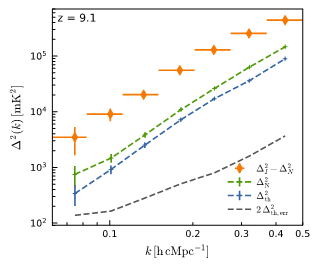 Figure 3: This Figure shows the LOFAR EoR recent results. Shown are final 10 nights Stokes I spherically averaged power spectra after residual foreground removal and noise bias removal (orange). The green and blue dashed lines represent, respectively, the estimated frequency-uncorrelated noise (∆2N) and thermal noise (∆2th) power of the 10 nights dataset. The black dashed line represents the 2σ upper limit theoretically achievable if the residual of the 10 nights dataset were thermal noise dominated. From Mertens et al. 2020.
The redshifted 21 cm, especially, its EoR era, has been the target of a number of ground-based radio observato- ries, especially, radio interferometers. Unfortunately, these telescopes have not hitherto been able to measure the EoR signal power spectrum, simply because the data quality have not reached the required level of refinement in order to do so. In the last year, however, significant progress has been made and the reported upper limits have started to reach low enough values that allowed us to start excluding certain theoretical models. The best upper limits on the δTb power spectrum so far have been published in the last couple of years from three telescopes: LOFAR has reported a 2σ upper limit of (79.6 mK)2 at k ≈ 0.053 hcMpc−1; WMA has reported a 2σ upper limit of (43 mK)2 at k ≈ 0.14 hcMpc−1; and HERA, which has very recently published the best 2σ upper limits yet of (30.76 mK)2 at k ≈ 0.192 hcMpc−1. These results have been analyzed further to constraint theoretical models for LOFAR, MWA and HERA.
The most recent measurement of the 21 cm power spectrum measured at z ≈ 9.1 by the LOFAR EoR-KSP, is shown in Fig. 3 (Mertens et al. 2020).
Figure 3: This Figure shows the LOFAR EoR recent results. Shown are final 10 nights Stokes I spherically averaged power spectra after residual foreground removal and noise bias removal (orange). The green and blue dashed lines represent, respectively, the estimated frequency-uncorrelated noise (∆2N) and thermal noise (∆2th) power of the 10 nights dataset. The black dashed line represents the 2σ upper limit theoretically achievable if the residual of the 10 nights dataset were thermal noise dominated. From Mertens et al. 2020.
The redshifted 21 cm, especially, its EoR era, has been the target of a number of ground-based radio observato- ries, especially, radio interferometers. Unfortunately, these telescopes have not hitherto been able to measure the EoR signal power spectrum, simply because the data quality have not reached the required level of refinement in order to do so. In the last year, however, significant progress has been made and the reported upper limits have started to reach low enough values that allowed us to start excluding certain theoretical models. The best upper limits on the δTb power spectrum so far have been published in the last couple of years from three telescopes: LOFAR has reported a 2σ upper limit of (79.6 mK)2 at k ≈ 0.053 hcMpc−1; WMA has reported a 2σ upper limit of (43 mK)2 at k ≈ 0.14 hcMpc−1; and HERA, which has very recently published the best 2σ upper limits yet of (30.76 mK)2 at k ≈ 0.192 hcMpc−1. These results have been analyzed further to constraint theoretical models for LOFAR, MWA and HERA.
The most recent measurement of the 21 cm power spectrum measured at z ≈ 9.1 by the LOFAR EoR-KSP, is shown in Fig. 3 (Mertens et al. 2020).
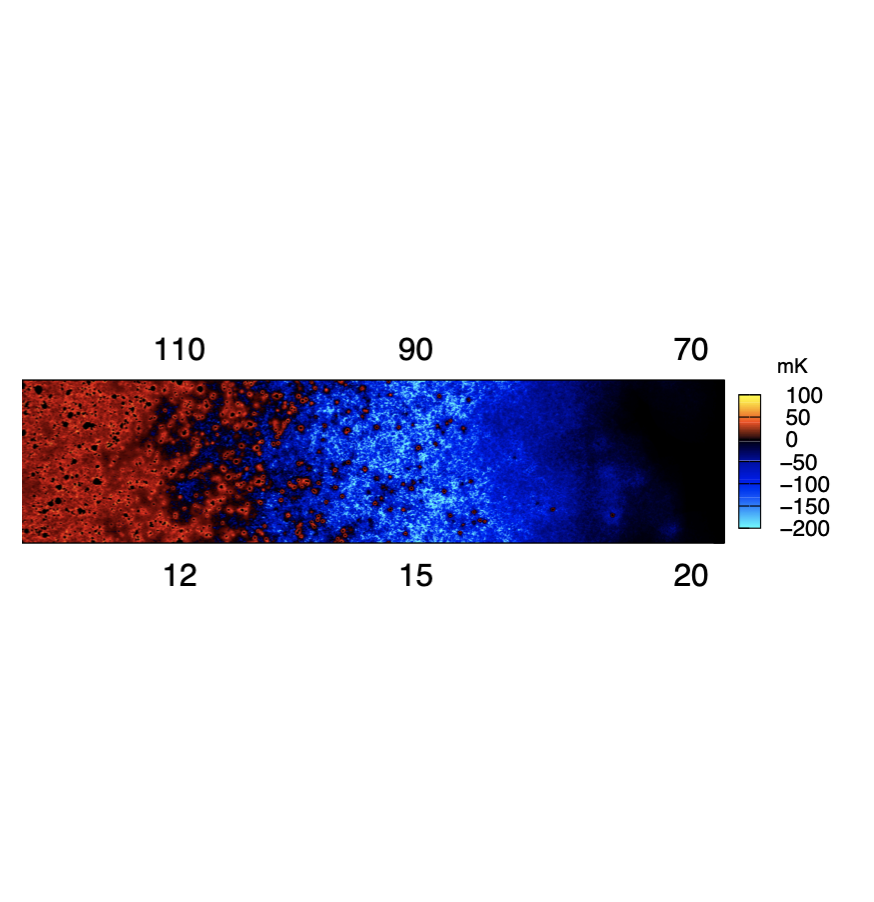
The Epoch of Reionization and Cosmic Dawn
Paper: Zaroubi, S. 2013. The Epoch of Reionization. A chapter in the book entitled ”The first galaxies: Theoretical Predictions and Observational Clues” Wiklind, Tommy, Mobasher, Bahram, Bromm, Volker (Eds.) Astrophysics and Space Science Library 396, page 45.
Modern cosmology presents a comprehensive and quantitively accurate description of the Universe’s properties, since the moment it began until its gas became neutral and transparent, about 380 thousand years after the Big Bang. From these early stages, a billion years later emerged the galaxies and stars-filled Universe, that we know very well. What happened since hydrogen became neutral, and for the subsequent billion years, is still shrouded in mystery and uncertainty. One of the few observational probes, if not the only one, with which to study the first billion years of our Universe’s history is a radiation emitted from neutral hydrogen, known due its wavelength as the 21 cm radiation. With this radiation we can study the Universe’s first billion years and the three eras that it straddles. The first era, known as the Universe’s Dark Ages, refers to the period before the emergence of any astrophysical sources (e.g., first stars). The second era, known as the Cosmic Dawn, is distinguished by the emergence of the first radiation-emitting objects (e.g., first stars), that start heating the hydrogen in the intergalactic medium. The third era, known as the Epoch of Reionization (EoR), is the period in which the hydrogen ionization process became the dominant process, lasting until the Universe is completely ionized and neutral hydrogen beomce scarce. The main aim of my current research is to detect The Epoch of Reionization and Cosmic Dawn (see Figure 1) with the European LOFAR radio telescope and the international Square Kilometer Array.
 Figure 1: This figure shows a sketch of the likely development of the differential brightness temperature of the 21 cm signal emitted from neutral hydrogen during the Cosmic Dawn (z=20-12, i.e., the blue part of the map) and the EoR (z=12-7, i.e., the red part of the map), in absorption and in emission, respectively. Notice that the absorption features (negative δTb) can be much deeper than those of the emission (positive δTb) (The figure by Dr. Raghunath Ghara).
Figure 1: This figure shows a sketch of the likely development of the differential brightness temperature of the 21 cm signal emitted from neutral hydrogen during the Cosmic Dawn (z=20-12, i.e., the blue part of the map) and the EoR (z=12-7, i.e., the red part of the map), in absorption and in emission, respectively. Notice that the absorption features (negative δTb) can be much deeper than those of the emission (positive δTb) (The figure by Dr. Raghunath Ghara).
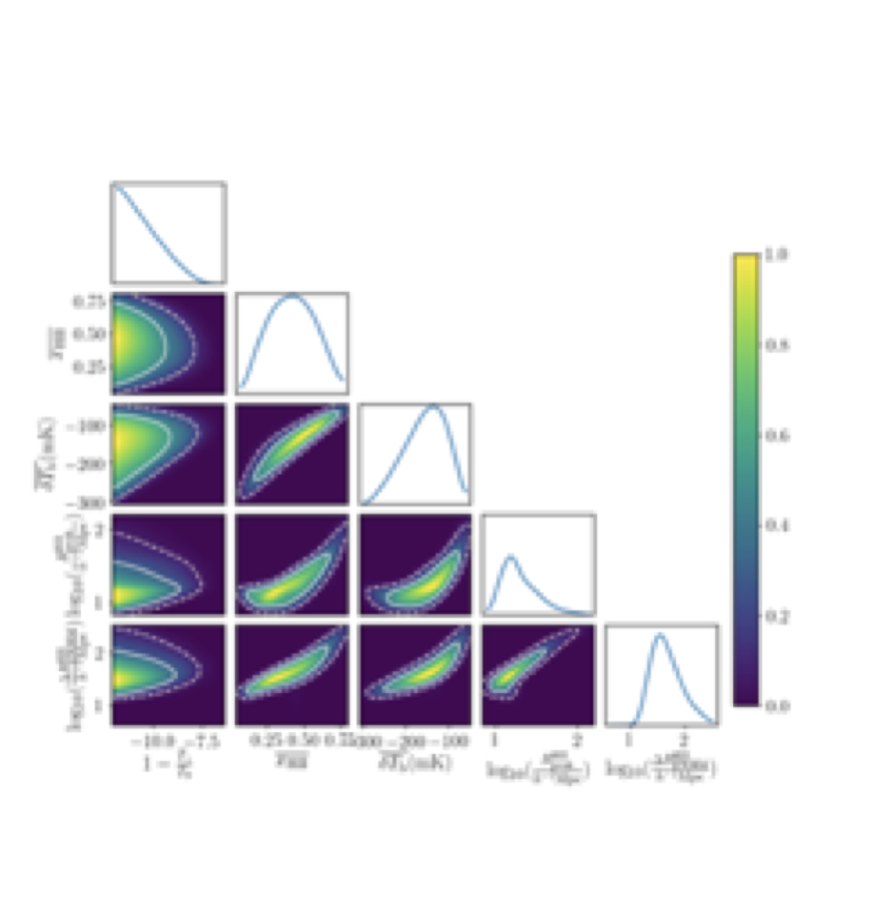
Constraining Cosmological models with The LOFAR EoR Upper
Paper: R. Ghara, S.K. Giri, G. Mellema, B. Ciardi, S. Zaroubi, I.T. Iliev, L.V.E. Koopmans, E. Chapman, S. Gazagnes, B.K. Gehlot, A. Ghosh, V. Jelic ́, F. G. Mertens, R. Mondal, J. Schaye, M. B. Silva, K. M. B. Asad, R. Kooistra, M. Mevius, A. R. Offringa, V. N. Pandey, and S. Yatawatta. Constraining the intergalactic medium at z ≈ 9.1 using LOFAR Epoch of Reionization observations. MNRAS, 493[4]:4728–4747, Feb. 2020.
The power spectrum measured by Mertens et al. (2020) has been used to rule out certain cosmological models with extreme IGM parameters by Ghara et al. (2020). Figure 4 shows the likelihood analysis of this power spectrum in term of IGM properties from the paper.
 Figure 4: This figure shows constraints fiveIGM parameters, assuming a uniform Tspin scenario from an MCMC analysis using the LOFAR upper limit shown in the left panel. The color-bar shows the probability that models are ruled out. The solid and dashed curves show the 68% and 95% credible intervals of the ruled out models. The diagonal panels show the marginalized probability distribution by which each parameter value as used in the MCMC analysis is ruled out (Ghara et al. 2020)
Figure 4: This figure shows constraints fiveIGM parameters, assuming a uniform Tspin scenario from an MCMC analysis using the LOFAR upper limit shown in the left panel. The color-bar shows the probability that models are ruled out. The solid and dashed curves show the 68% and 95% credible intervals of the ruled out models. The diagonal panels show the marginalized probability distribution by which each parameter value as used in the MCMC analysis is ruled out (Ghara et al. 2020)
